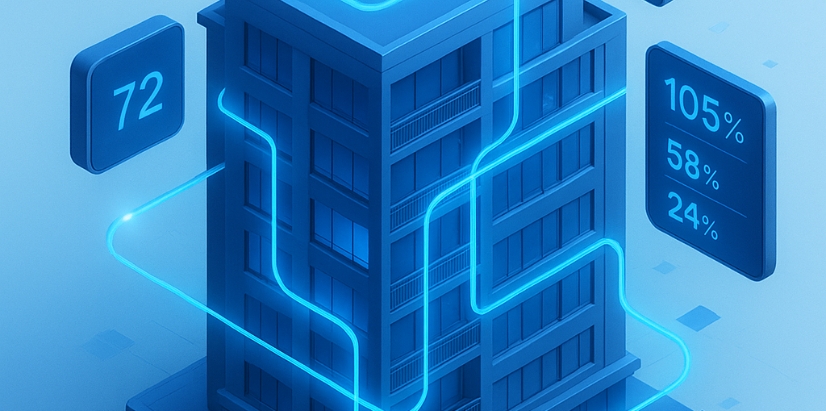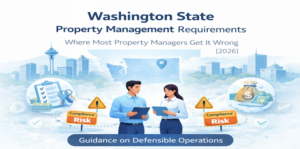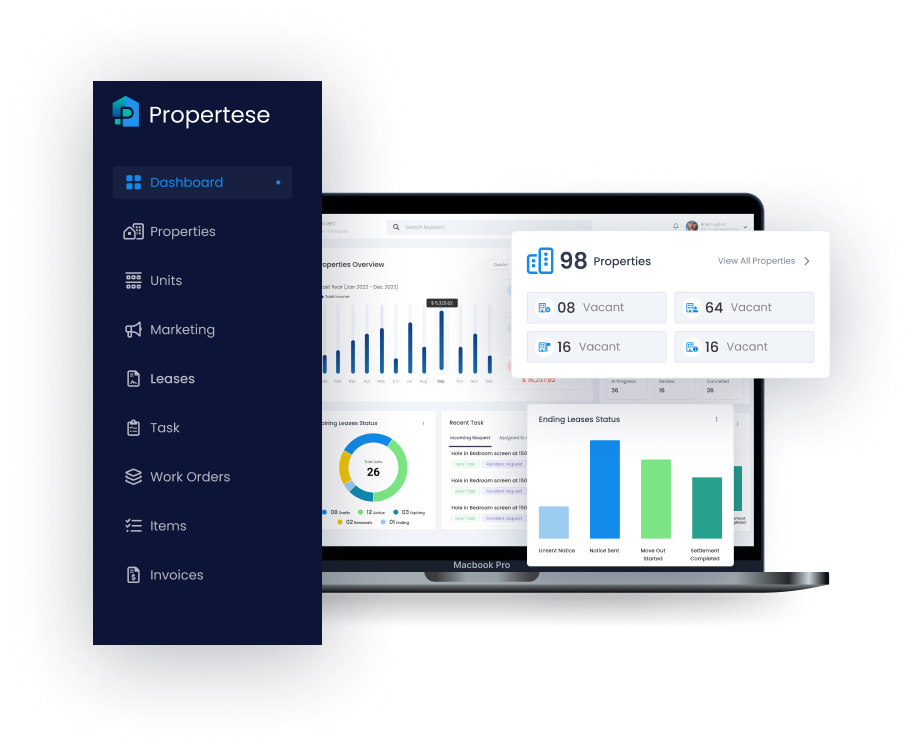
If you’re a rental property manager, you’re already aware that increasing utility expenses and wasted energy quietly devour profits. Tenants expect comfort, investors desire increased returns, and regulators insist on sustainability. What’s missing? An Energy Management System (EMS) that reduces waste, saves costs, and delivers results with quantifiable ROI.
Here in this blog, we’ll dissect:
- What is an Energy Management System for property management?
- Why EMS achieves high ROI in real-life scenarios.
- Optimal practices for increasing energy efficiency.
- Evaluating ROI step by step.
- How systems like maintenance request management can scale savings.
As a landlord, property manager, or real estate investor, this guide shows you how EMS changes property performance.
What is an Energy Management System (EMS) in Property Management?
An Energy Management System (EMS) is a software-based solution that tracks, controls, and optimizes energy consumption throughout a property or portfolio. Imagine it as the “brain” of a building’s utilities, which monitors electricity, HVAC, water, and lighting in real-time.
Some of the most essential EMS features are:
- Smart meters and IoT sensors.
- Real-time dashboards with analytics.
- Automated HVAC and lighting control.
- Predictive maintenance alerts.
- Insights into tenant energy consumption.
In plain terms, EMS allows you to save money on energy and keep the tenants happy.
Why Should Property Managers Care About EMS ROI?
Energy costs usually constitute 25–30% of all operating costs in residential and commercial buildings. Properly executed EMS will help save those expenses by 15–25% within the first year.
ROI Gains You Can Anticipate:
- Smaller utility bills → Immediate cost savings.
- Rapid maintenance and fewer failures → Reduced emergency repair cost.
- Happier tenants → Comfortable, well-managed environments.
- Increased property value → Energy-efficient buildings command premium rents.
- Regulatory compliance → No fines, future-proofing your assets.
- Sustainability branding → Strong appeal to green-conscious renters.
Example: A 100-unit apartment complex with EMS saved $40,000 a year on electricity with HVAC schedule automation.
How to Calculate ROI for Energy Management Systems
Property managers usually wonder: “Is the investment really worthwhile?” Here’s a simple ROI formula for EMS:
ROI (%) = (Annual Savings – EMS Cost) / EMS Cost × 100
Example:
- EMS setup cost: $50,000
- Annual energy savings: $20,000
- ROI Year 1 = (20,000 – 50,000) / 50,000 × 100 = -60%
- But in Year 3, cumulative savings amount to $60,000 → ROI = +20%
This illustrates that EMS is a long-term investment. Payback period is usually 2–4 years based on building size and usage.
Best Practices for Maximizing ROI with EMS

To make your EMS deliver optimum value, use the following strategies:
1. Begin with an Energy Audit
- Pinpoint energy hotspots (HVAC, lighting, water heaters).
- Prioritize where energy is consumed the most.
2. Establish Clear ROI Goals
- Establish benchmarks (e.g., 20% in electricity savings in 12 months).
- Align goals with tenant satisfaction and owner expectations.
3. Incorporate EMS into Property Management Software
When EMS integrates with your property management system, you have one dashboard for energy + rent + maintenance. See how platforms like Propertese improve property management efficiency.
4. Use Automation for HVAC and Lighting
- Smart thermostats regulate temperatures when units are unoccupied.
- Motion-sensor lighting eliminates waste in shared spaces.
5. Monitor Tenant Behavior
- Provide energy reports to tenants to promote conservation.
- Reward sustainable behavior (e.g., discounts or incentives).
6. Invest in Predictive Maintenance
- EMS can identify abnormal energy surges → indicates problematic equipment.
- Repairing upfront prevents costly repairs and tenant complaints.
7. Combine EMS with Sustainability Programs
- Solar panels + EMS = higher ROI.
- Green certifications (LEED, Energy Star) attract premium tenants.
The Overlooked Factor: Support & Maintenance Request Management
Even the finest EMS cannot provide maximum ROI if maintenance problems remain unresolved. A leaky HVAC unit, damaged insulation, or malfunctioning lighting fixture can negate months of energy savings. The actual difference lies in how quickly you address issues.
That’s where a specialized Support & Maintenance Request Management Software becomes essential. With streamlined request processing, property managers can:
- Catch inefficiencies early – Tenants report issues before they turn into significant problems.
- Track and prioritize work – Schedule maintenance quickly.
- Reduce operational expenses – Avoid costly breakdowns.
- Improve tenant experience – Quick repairs foster trust and loyalty.
Propertese offers an advanced feature to optimize support and maintenance request management. By linking this to your EMS, you not only decrease wasted energy but also create a responsive property ecosystem in which cost savings and tenant satisfaction go hand in hand.
Key Metrics (KPIs) to Track in EMS ROI
To gauge success and demonstrate value, monitor these:
- Energy Cost Savings (%) – What % decrease versus baseline.
- Payback Period (years or months) – How many years or months until the savings pay back the cost.
- Carbon Emissions Reduction (tons CO₂) – Eco-impact.
- Tenant Satisfaction / Comfort Scores – Survey feedback.
- Maintenance Response Time – Time to fix problems.
- Equipment Downtime – More uptime = increased efficiency.
- Utility Bills vs. Benchmark Costs – Comparison with similar buildings or time periods.
ROI Examples
Example 1: Office Complex in Dubai
EMS cost: $120,000
Annual savings: $45,000
Payback: ~2.7 years
Additional benefit: Fewer tenant complaints regarding temperature.
Example 2: Multifamily Housing in Texas
EMS cost: $75,000
Annual savings: $22,500
Payback: ~3.3 years
Maintenance expenditures fell 15% after being paired with robust request-management procedures.
Example 3: UK Student Housing
EMS + Installation of Solar: $200,000
Yearly savings: $65,000
Payback: ~3 years
Enhanced occupancy rate through sustainability branding.
Common Mistakes Property Managers Make with EMS
| Mistake | Why It Hurts ROI | How to Avoid It |
| Not training staff properly | System underutilized; energy savings low | Conduct workshops; use clear SOPs. |
| Ignoring maintenance requests | Faulty equipment wastes energy | Employ support & maintenance tools; see below. |
| Choosing the cheapest system without scalability | Hidden upgrade costs; poor data integration | Evaluate long-term features and support. |
| Overlooking tenant engagement | Tenants leave lights on; misuse appliances | Educate; share data; offer incentives. |
| Failing to monitor performance regularly | Drift in savings; unnoticed issues | Use dashboards; set monthly/quarterly reviews. |
How EMS Supports Occupancy and Marketing
Modern renters, especially Gen Z and millennials, look for eco-friendly housing. Properties with EMS can advertise:
- Lower utility bills for tenants.
- Green certifications.
- Smart building features.
This boosts occupancy rates, which we’ve also covered in our guide on effective property advertising.
The Role of AI in Energy Management
AI-powered EMS goes beyond monitoring—it predicts patterns.
AI benefits include:
- Forecasting peak energy loads.
- Adjusting HVAC based on weather predictions.
- Learning tenant preferences for optimal comfort.
For deeper insights, check out how AI is reshaping property management software.
Emerging Trends & Future Value
IoT & Smart Sensors → greater accuracy in energy consumption control.
Machine Learning for Predictive Diagnostics → prevent breakdowns & inefficiency.
Renewables & Off-Grid Power → integrated solar, battery storage with EMS.
ESG (Environmental, Social, Governance) Reporting Requirements → growing landlord/tenant demand.
Regulations on Energy Efficiency → government regulations are trending tighter.
Final Thoughts
Energy Management Systems are no longer a thing of luxury, but a necessity in contemporary property management. When combined with robust support tools such as request-management software, EMS becomes more than just a cost-saving tool. It becomes a system that guarantees long-term savings, tenant satisfaction, and increased property value.
If you are looking to integrate EMS with intelligent property management software, Propertese offers solutions that simplify your operations, accelerate them, and make them more profitable. From support and maintenance request management to full-scale property management efficiency, Propertese helps you build a sustainable future while improving ROI today.
Table of Contents
Stay Updated
Subscribe to get the latest news, industry trends, blog posts, and updates...




